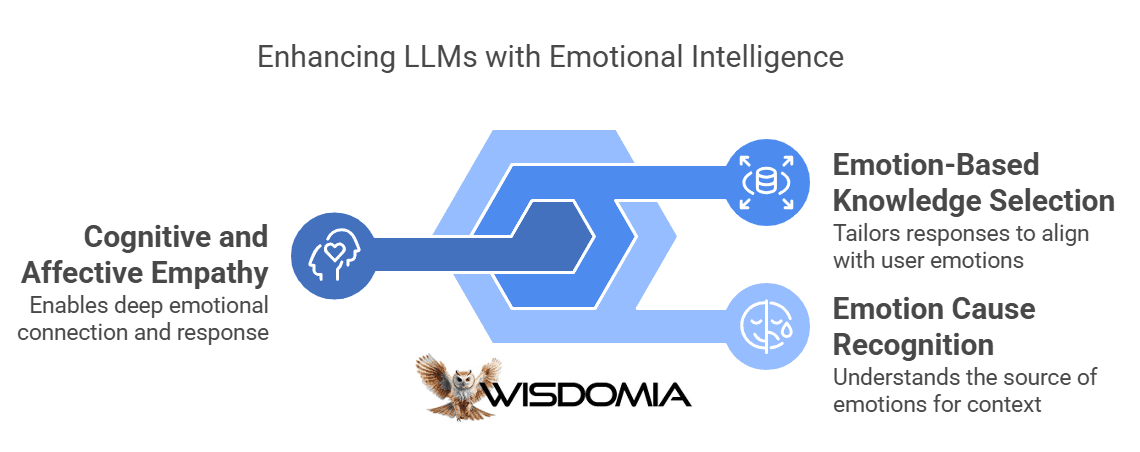Emotional Intelligence and Large Language Models: Bridging the Gap Between AI and EQ
Dinis GuardaAuthor
Fri Mar 21 2025

Large Language Models (LLMs) have made significant strides in understanding and generating human language, yet their ability to replicate human emotions remains a key area of research. Emotional intelligence (EI) is crucial in this context, as it enhances the performance of LLMs by enabling them to better perceive, understand, and respond to users' emotional states.
Large Language Models (LLMs) have made significant strides in understanding and generating human language, yet their ability to replicate human emotions remains a key area of research. Emotional intelligence (EI) is crucial in this context, as it enhances the performance of LLMs by enabling them to better perceive, understand, and respond to users' emotional states. This ability is essential for fostering effective communication and facilitating smooth social interactions. As LLMs evolve into more advanced conversational AI assistants, integrating EI-related tasks is key to ensuring their success in general intelligence applications.
The Nature of Emotional Intelligence in Humans
Emotional intelligence encompasses the ability to recognise, understand, manage and effectively express one's emotions whilst also navigating the emotional landscape of others. In human interaction, EQ serves as the cornerstone of empathy, effective communication and meaningful relationships.
Traditional psychological frameworks, such as those proposed by Daniel Goleman, divide emotional intelligence into several key components:
- Self-awareness: Recognising one's emotions and their impact
- Self-regulation: Managing emotions appropriately
- Social awareness: Discerning the emotions of others
- Relationship management: Guiding interactions successfully
The Current Landscape of Emotional Intelligence in AI
Today's most advanced LLMs demonstrate remarkable capabilities in mimicking certain aspects of emotional intelligence:
- When faced with a distressed user query, these systems can offer comforting responses.
- They can adjust their tone to match the gravity of a situation or the formality of a context.
- They can even recognise when certain topics might be emotionally sensitive.
These abilities represent significant progress in creating AI systems that can engage with humans in ways that feel natural and considerate. Yet, important limitations remain.
Emotional Understanding in LLMs

LLMs can be improved by integrating emotional stimuli, enabling them to better grasp the context and subtleties of human interactions. This deeper understanding is essential for producing empathetic responses. Here are some key approaches:
- Emotion Cause Recognition: This approach goes beyond simply detecting the emotion itself; it aims to understand what specific event, situation, or interaction has led to that emotional response. By recognising the cause of an emotion, LLMs can generate more contextually appropriate and empathetic responses, addressing not only the emotion but also its source.
- Emotion-Based Knowledge Selection: This approach involves tailoring the AI's responses based on the user's emotional state. Rather than providing generic information, the LLM selects and prioritises knowledge that aligns with the emotions detected in the user's input. For example, if a user expresses frustration or sadness, the LLM might choose to offer comforting, supportive, or encouraging content, while a more neutral or happy emotional state might prompt an informative or engaging response. This approach helps the AI generate more relevant and empathetic responses.
- Cognitive and Affective Empathy:
- Cognitive Empathy involves the AI's ability to understand and recognise what another person is feeling by interpreting their emotional state and perspective. It enables the LLM to grasp the emotions behind the words and the context of the interaction, which helps it respond appropriately in conversations.
- Affective Empathy goes a step further by allowing the LLM to share or mirror the emotional experience of the user. It involves recognising not just the emotion, but also feeling or responding to it in a way that aligns with the user's emotional state. This enables the AI to offer more compassionate and emotionally resonant responses.
Potential Benefits of Emotionally Intelligent LLM Characters
- Enhanced User Engagement and Satisfaction: Emotionally intelligent LLM characters can greatly improve user engagement and satisfaction. By identifying and addressing user emotions, these characters enable more personalised and empathetic interactions. Research indicates that users often view emotionally intelligent AI systems as more trustworthy, resulting in enhanced satisfaction and deeper engagement.
- Improved Contextual Understanding: Integrating emotional intelligence into LLM characters enhances their ability to understand context. By detecting emotions within a conversation, LLM characters can produce responses that are more relevant and suitable. This not only improves the quality of interactions but also fosters a deeper understanding between users and the AI system.
- Personalized User Experiences: Emotionally intelligent LLM characters can offer personalised user experiences by adjusting their responses according to user emotions. This level of customization can enhance user satisfaction, boost loyalty, and improve retention rates.
The Fundamental Gap

Despite their impressive capabilities, LLMs lack several fundamental components of genuine emotional intelligence:
- Experiential Understanding: LLMs have no lived experience of emotions, relying instead on statistical patterns observed in text.
- Embodied Cognition: Human emotions involve physical sensations and neurochemical processes that LLMs simply do not possess.
- Authentic Empathy: While LLMs can simulate empathetic responses, they do not experience the genuine emotional resonance that characterises human empathy.
- Self-awareness: LLMs have no intrinsic understanding of themselves as entities with emotional states.
Case Study on Emotionally Intelligent LLM Characters: Chatbot with Emotional Intelligence
Johnson et al. (2023) conducted a case study on the development of a chatbot equipped with emotional intelligence. By integrating sentiment analysis, the chatbot identified user emotions and crafted responses that empathetically addressed their concerns. User feedback revealed increased satisfaction and engagement, highlighting the advantages of incorporating emotionally intelligent LLM-based characters into conversational systems.
Methodology
The study employs a mixed-methods approach, involving 24 ordinary users for reflections and 34 for interviews to gather immediate feedback and in-depth insights into user experiences with banking chatbots. Additionally, a focus group comprising 18 IT and financial experts from Qatari banks provides professional perspectives on improving chatbot services. Conducted within Qatar's banking sector, the study focuses on individual encounters with chatbots to identify key determinants of consumer-chatbot engagement.
Findings:
The findings suggest that integrating emotional intelligence into conversational systems can significantly improve interactions and outcomes for users, “Echoed Sentience” highlights those breakthrough moments when chatbots, powered by advanced algorithms, reflect human empathy, showcasing their potential to enhance and deepen the human-bot connection.
This aspect of chatbot development transcends traditional engagement, aiming to connect with users on a more profound and intuitive level—a connection that many users reported experiencing. “The chatbot did not just answer; it felt like it truly got my concerns,” expressed one user. Another user reflected, “There was a moment when I felt like I was conversing with a real bank representative. “ Such experiences emphasize the successful integration of empathetic algorithms.
Final Thoughts
Large Language Models have unquestionably narrowed the gap between artificial intelligence and emotional intelligence. They demonstrate remarkable capabilities in recognising and responding to emotional content in text, offering valuable tools for numerous applications.
However, fundamental differences between computational pattern recognition and human emotional experience ensure that a significant gap remains. Rather than viewing this as a shortcoming, we might better understand it as a reminder of the unique qualities of human emotional intelligence.
The most promising path forward may lie not in attempting to replicate human emotional intelligence perfectly, but in developing AI systems that complement human emotional capabilities, compensating for our limitations whilst respecting the irreplaceable nature of genuine human connection and empathy.
previous
Integrating EQ in technology: Building Human Centric Systems
next
Emotional Intelligence in AI Agents for Better Human Interaction
Share this

Dinis Guarda
Author
Dinis Guarda is an author, entrepreneur, founder CEO of ztudium, Businessabc, citiesabc.com and Wisdomia.ai. Dinis is an AI leader, researcher and creator who has been building proprietary solutions based on technologies like digital twins, 3D, spatial computing, AR/VR/MR. Dinis is also an author of multiple books, including "4IR AI Blockchain Fintech IoT Reinventing a Nation" and others. Dinis has been collaborating with the likes of UN / UNITAR, UNESCO, European Space Agency, IBM, Siemens, Mastercard, and governments like USAID, and Malaysia Government to mention a few. He has been a guest lecturer at business schools such as Copenhagen Business School. Dinis is ranked as one of the most influential people and thought leaders in Thinkers360 / Rise Global’s The Artificial Intelligence Power 100, Top 10 Thought leaders in AI, smart cities, metaverse, blockchain, fintech.
More Articles

The Digital Convergence: When Images Became Everything, Everywhere, All at Once

Modern Revolutions and the Digital Explosion: Images That Shattered and Rebuilt Reality

Renaissance Humanism and the Birth of the Modern Gaze: Images That Taught Us to See Ourselves

When Vision Becomes Destiny: The First 25 Images That Shaped Human Consciousness

What a Small Indian Village Teaches the World About Sustainability





